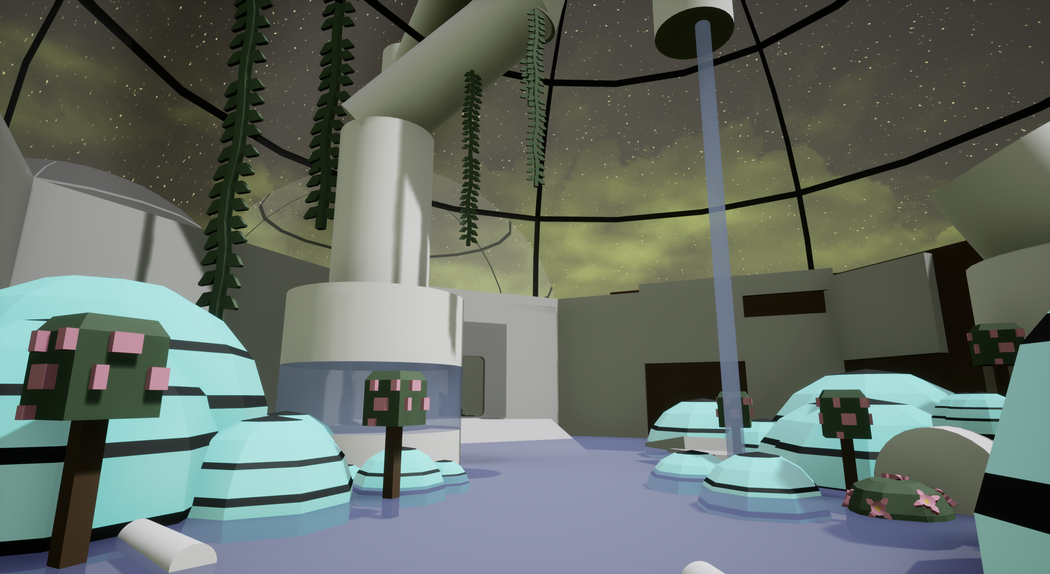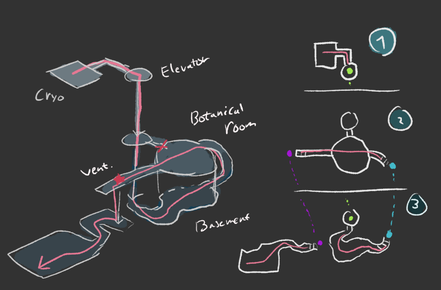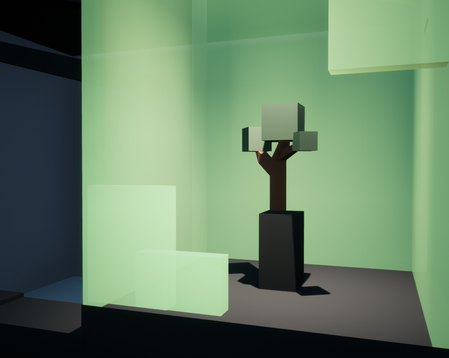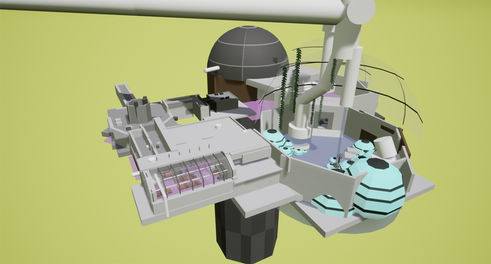Level Designer
The Laboratory
Good Morning
You've woken up in an abandoned laboratory. With no signs of life you decide to find your way outside, using a water can to alter the plant-life around you.
Goals
- Create a Linear Puzzle Game.
- Create a game that takes place indoors.
- Create a mechanic that feels fun to use and allows for a lot of experimentation in a short time.
- Utilize one object that must be brought with you the entire game (like the Companion Cube).
- Study Portal 2 for design cues
Specifics
Created in unreal
2 weeks fulltime
All assets created by myself
References
This project looked into Portal and Portal 2 for references in terms of puzzle design and level design.
Vision
The goal of this project was to create a level design experience focused around gameplay. With the time constraint of two weeks however that meant I had to work effectively and quickly, with much work going into creating a mechanic that felt interesting, while also being easy for me to script in Unreal and easily expanded upon.
Process
Preprod
The first week went into creating the groundwork for the level. During this time the idea went through several iterations.
It started as a physics-based puzzle game, where the player could only pick up and set down items and would have to navigate a laboratory and get out. This idea wasn't well received, as some feedback pointed out:
"This idea has been done a million times before. What makes your special?"
That gave birth to The Stick.
It was a silly idea. Creating a single item, a stick, a long session then went into all the things one could do with a stick.
Taking design cues from portal I decided to make it an item you had to bring with you through the whole level, like the Companion Cube, with mechanics chosen to facilitate that concept.
What can you do with a stick?
- Whack enemies and debris
- Hold up the stick in front of you to hide from enemies
- Being a plant, the stick can such up poisonous gas
- The stick can neutralize toxic water
- Fire is double deadly, as it will kill you and the stick
- It can be placed into special pots which will send plant energy to other plants, making them grow
- It can be placed down and be grown into a giant tree
- This tree can be used as a platform, or to block dangerous things such as water or enemies
- The stick transforms into a tree when given sunlight or water
- Carve the stick into the side of a tree to make activate a tree mechanic
- Use it as a weight
- Use the stick as a perch for a bird
- Can be used to "plug holes" to stop leaks
In the end I went with two mechanics.
There was poisonous fog you could only pass when holding the stick. I included this so I had a way to force the player to bring the stick with them. And the stick could be placed down in special soil to activate other plants. This was done so you would have to part with the stick, and so I could easily add more secondary mechanics without having to change the behaviour of the stick. A third mechanic had to be introduced, since because you had to bring the stick with you all mechanics it activated were only temporary, so I created buttons that could be weighed down by apples you grew to permanently open doors.
This however, is not where the iteration ended.
Birth of the Can
The Stick was changed into a watering can. The primary reason was logic; walking around watering plants with a magical can felt more believable than having a stick that could be placed in convenient spots. The can allowed more freedom, no longer did the player have to weight down buttons when they could just water a plant and have it grow permanently, not to mention being able to water just about everything around you was plain fun.
Blockout
So here's the problem. So much time was spent iterating on the mechanics and coming up with a solid idea, that a mere two days were left to create the actual level. While I'm very glad the idea turned out like it did, It took a great toll on the level design.
I had set some basic metrics such as the jump and height, inspired by the movement from Portal 2, and had figured out a good size for the rooms in earlier sketches. So I started out with creating a layout for all the rooms, trying to tie them together and creating a map of the laboratory and what it contained.
Rough Whitebox
The idea was that the laboratory had several wings dedicated to various research into plants that could provide a habitable atmosphere on foreign planets. But something went wrong, the lab exploded, and you woke up in the aftermath.
For the whitebox I got three sub-mechanics done, and tried to present them with a ki-sho-ten-ketsu approach. I had too little time to develop the puzzles properly, so this whitebox instead functions as a show of concept. Time allowing I would've liked to do more iterations and get more feedback.
Walkthrough
The Idea
I tried to apply the idea of Ki-Sho-Ten-Ketsu; introduction of a mechanic, letting the player learn it, test them with a proper puzzle forcing them to think in different ways, and finally offer a reward. However with the time constraints the Ten part was abandoned in most cases, focusing on just introducing the mechancis.
I would've liked to revisit this level and add additional rooms for each of the three mechanics, with puzzles that would force the player to stop and think for a while, and then begin combining the mechanics so they'd have to consider it all at once. The final room bears traces of this, forcing the player to use seeds to navigate to the water bulb.
Reflection
What did I learn?
I find it hard to evaluate this project due to the extremely constrained time. Coming at the end of the portfolio session of my education meant additional stress, and all of this combined ended up with a project where I had little time to look back and had to keep forcing myself forward.
The end product is... okay. I'm very satisfied I took the time to lay a proper groundwork, as it greatly helped facilitate the overall design even if the actual level design took a serious blow since it only had two days of development. Therein is naturally what I'm least satisfied with; my goal was to create a level that was genuinely fun to play, but right now it feels more like a long tutorial than the puzzle experience I had hoped for. Had I more time, I would've liked to get feedback and player-testing on this level and revamp it.
Still, I'm glad I powered though and got something out. This is a product that can be explored and debated, and I feel the basic idea is rather solid. Had I panicked and went with the original idea - a simple physics game - the end result would've been bland and not stood for the creativity I wish to bring into my design. The ability to let go, rework and know when to scrap an idea - whether because it's bad, doesn't fit, or there's not the time to develop it properly - is good experience to have.






















